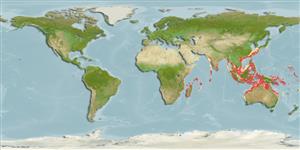Common names from other countries
Environment: milieu / climate zone / depth range / distribution range
Écologie
marin démersal; profondeur 45 - 177 m (Ref. 27821). Deep-water
Indo-West Pacific: southern India and Sri Lanka to the Philippines, south to northern Australia and Papua New Guinea (Ref. 6192).
Taille / Poids / Âge
Maturity: Lm ? range ? - ? cm
Max length : 30.0 cm TL mâle / non sexé; (Ref. 48635)
Differ in color from the more common D. orientalis by the lack of blue lines in the pectoral fins and has a centrally placed dark blotch on the fin instead. Also the body lacks black spots (Ref. 48635).
Found in the continental shelf (Ref. 7300, 75154). Rarely observed due to mud-preferred habitats (Ref. 48635). Benthic (Ref. 75154). Not fished commercially but taken incidentally throughout its range. Usually caught near shore. Marketed fresh occasionally (Ref. 3392).
Life cycle and mating behavior
Maturité | Reproduction | Frai | Œufs | Fécondité | Larves
Eschmeyer, W.N., 1997. A new species of dactylopteridae (Pisces) from the Philippines and Australia, with a brief synopsis of the family. Bull. Mar. sci. 60(3):727-738. (Ref. 27821)
Statut dans la liste rouge de l'IUCN (Ref. 130435)
CITES (Ref. 128078)
Not Evaluated
Menace pour l'homme
Harmless
Utilisations par l'homme
Pêcheries: intérêt commercial mineur; Aquarium: Commercial
Plus d'informations
Noms communsSynonymesMétabolismePrédateursÉcotoxicologieReproductionMaturitéFraiFéconditéŒufsDéveloppement de l'œuf
RéférencesAquacultureProfil d'aquacultureSouchesGénétiqueElectrophoresesHéritabilitéPathologiesTraitementMass conversion
CollaborateursImagesStamps, Coins Misc.SonsCiguateraVitesseType de nageSurface branchialeOtolithesCerveauxVision
Outils
Articles particuliers
Télécharger en XML
Sources Internet
Estimates based on models
Preferred temperature (Ref.
115969): 20.4 - 27.9, mean 25.2 (based on 461 cells).
Phylogenetic diversity index (Ref.
82804): PD
50 = 0.5234 [Uniqueness, from 0.5 = low to 2.0 = high].
Bayesian length-weight: a=0.00389 (0.00180 - 0.00842), b=3.12 (2.94 - 3.30), in cm Total Length, based on all LWR estimates for this body shape (Ref.
93245).
Niveau trophique (Ref.
69278): 3.5 ±0.5 se; based on size and trophs of closest relatives
Résilience (Ref.
120179): Haut, temps minimum de doublement de population inférieur à 15 mois (Preliminary K or Fecundity.).
Fishing Vulnerability (Ref.
59153): Low vulnerability (20 of 100).
